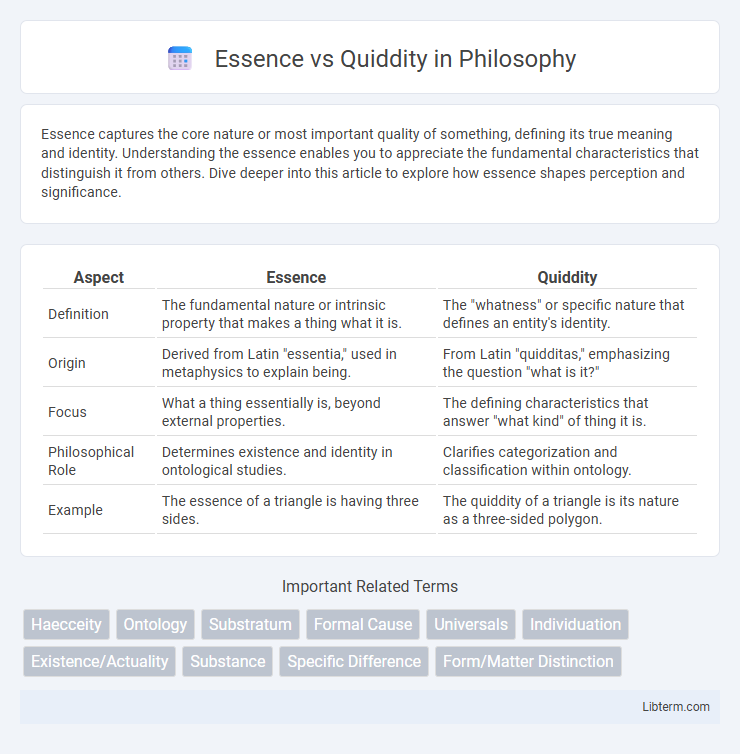Essence captures the core nature or most important quality of something, defining its true meaning and identity. Understanding the essence enables you to appreciate the fundamental characteristics that distinguish it from others. Dive deeper into this article to explore how essence shapes perception and significance.
Table of Comparison
| Aspect | Essence | Quiddity |
|---|---|---|
| Definition | The fundamental nature or intrinsic property that makes a thing what it is. | The "whatness" or specific nature that defines an entity's identity. |
| Origin | Derived from Latin "essentia," used in metaphysics to explain being. | From Latin "quidditas," emphasizing the question "what is it?" |
| Focus | What a thing essentially is, beyond external properties. | The defining characteristics that answer "what kind" of thing it is. |
| Philosophical Role | Determines existence and identity in ontological studies. | Clarifies categorization and classification within ontology. |
| Example | The essence of a triangle is having three sides. | The quiddity of a triangle is its nature as a three-sided polygon. |
Understanding Essence and Quiddity
Essence refers to the fundamental nature or intrinsic characteristics that define an entity, making it what it fundamentally is, while quiddity denotes the "whatness" or the specific set of attributes that make an entity uniquely itself. Understanding essence involves grasping the core attributes that are necessary and universal to an entity's identity across possible worlds. Quiddity emphasizes the distinct qualities that differentiate an entity from all others, highlighting its individuality within the broader category defined by essence.
Defining Essence: Core Meaning
Essence represents the fundamental nature or intrinsic qualities that define the true identity of an entity, distinguishing it from all others. Quiddity, by contrast, refers to the specific 'whatness' or the exact set of characteristics that constitute the entity's unique identity. Defining essence involves identifying those core attributes without which the entity would cease to be what it inherently is.
What is Quiddity? Philosophical Roots
Quiddity refers to the inherent nature or "whatness" of a thing, defining its essence and distinguishing it from other entities. Rooted in medieval Scholastic philosophy, particularly in the works of Thomas Aquinas and Aristotle, quiddity explores the fundamental attributes that make an object or concept uniquely identifiable. This concept contrasts with existence, emphasizing the intrinsic qualities that constitute an entity's identity beyond its mere occurrence in reality.
Essence vs Quiddity: Key Differences
Essence defines the fundamental nature or intrinsic qualities that make an entity what it truly is, while quiddity refers to the specific "whatness" or the unique characteristics that distinguish one thing from another within a category. Essence addresses the core attributes necessary for an entity's identity, whereas quiddity emphasizes the individual features that differentiate it from others. Understanding the key differences between essence and quiddity is crucial in philosophy for distinguishing universal properties from particular traits.
Historical Perspectives on Essence and Quiddity
Historical perspectives on essence and quiddity trace back to ancient Greek philosophy, where essence (ousia) was understood as the fundamental nature defining an entity's existence, while quiddity (haecceity) described the "whatness" that makes an individual unique. Aristotle's metaphysics emphasized essence as the universal defining attributes necessary for something to be what it is, contrasting with medieval scholastic thinkers like Thomas Aquinas who further differentiated essence and existence in their ontology. The distinction evolved during the Middle Ages as debates around essence and quiddity shaped metaphysical and theological discourse, influencing later existential and phenomenological thought on identity and individuality.
Applications in Metaphysics
Essence defines the fundamental nature or indispensable qualities that make an entity what it is, while quiddity refers to the "whatness" or specific characteristics distinguishing one entity from another within the same category. In metaphysics, essence is crucial for understanding identity, persistence, and categorization of objects through necessary attributes, whereas quiddity aids in distinguishing individual entities by their unique properties. These concepts underpin debates on universals, identity over time, and the nature of reality in contemporary metaphysical discourse.
Essence and Quiddity in Linguistics
Essence in linguistics refers to the intrinsic nature and core meaning of a word or concept that defines its identity across contexts. Quiddity involves the specific characteristics or features that distinguish one linguistic item from others within the same category or class. Understanding the interplay between essence and quiddity helps linguists analyze how meaning is both universally stable and contextually variable in language use.
Relevance in Modern Philosophy
Essence defines the intrinsic nature or indispensable quality of an entity, while quiddity refers to the "whatness" or specific characteristics distinguishing it from others. Modern philosophy emphasizes essence in debates on identity, existence, and metaphysics, grounding ontological inquiries in real attributes rather than abstract definitions of quiddity. The relevance of essence persists in contemporary discussions on being and consciousness, shaping perspectives in existentialism, phenomenology, and analytic philosophy.
Examples Illustrating the Distinction
Essence refers to the fundamental nature or intrinsic properties that define what something is, such as the essence of water being its molecular composition H2O. Quiddity, on the other hand, denotes the specific characteristics that distinguish one entity from others within the same category, like the quiddity of a rose being its particular color, fragrance, and petal arrangement. For instance, the essence of a triangle is having three sides, while the quiddity may include being equilateral or isosceles.
Conclusion: Essence and Quiddity Unveiled
Essence defines the fundamental nature or intrinsic qualities that make an entity what it is, while quiddity captures the specific "whatness" or unique characteristics distinguishing it from others. Understanding essence allows for grasping the core existence of a subject, whereas quiddity offers insight into its particular identity and individuality. Together, essence and quiddity provide a comprehensive framework for analyzing being and existence in philosophical inquiry.
Essence Infographic

 libterm.com
libterm.com